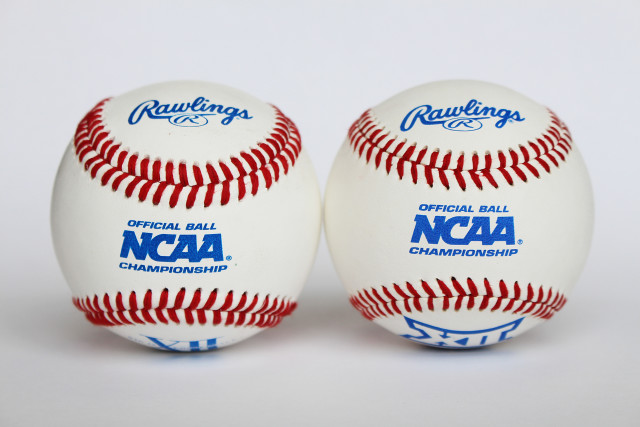College Baseball’s New Ball Explains Its Recent Battering
By Doug Waters
Reporting Texas

After the 2014 season, the NCAA switched to the flat-seam baseball (right) compared to the raised-seam ball (left). The new, flat-seam balls travel farther than their predecessor and led to more home runs in the 2015 season. Lukas Keapproth/Reporting Texas
From 2012 through 2014, hitters delivered a total of 16 home runs in the Men’s College World Series. In 2015 alone, there were 15.
What changed? The ball.
After the 2014 season, NCAA Division I baseball switched to a new ball that travels farther, making the game more exciting. After its first full season, I wanted to know how the ball changed the game. We all know a ball can’t talk, but if it could, here’s how an interview might go.
Q: What did you do in the off-season to change your appearance?
A: I’m not going to lie. I had a little work done. The game needed more runs, so my seams were lowered almost 2 centimeters.
Q: How does that help?
A: There’s a “drag effect” when I fly, and when my seams are lower, the drag decreases. The lower the seams, the farther I travel.
Q: I heard you did a lot more traveling this year.
A: Absolutely. I had to upgrade my frequent flier miles. Last year I went over the fence a little less than two times every five games. This year, three times for every five.
Q: What inspired the new version of you?
A: Lots of things. First, 2011-14 was the lowest four-year stretch for runs per game since 1972-75. In 2011, Division I baseball began using new bats that weren’t as powerful as the old model. The game needed to come back into balance. Eighty-seven percent of Division I baseball coaches in 2013 said they supported a change in my construction.
Q: You mentioned the new “BBCOR” bats. Can you explain to our readers a bit about “bat-ball coefficient of restitution”?
A: BBCOR bats are less powerful with a smaller sweet spot than previous bats. In 2011, the NCAA adopted the new bats because people believed hitters had an unfair advantage over pitchers. I enjoyed the BBCOR bats because it didn’t hurt as much when a guy squared me up.
Q: When was the last time you made a change to your appearance?
A: That’s a question I don’t have much of an “official” answer to. The live-ball era began in 1920, so I changed then along with Major League Baseball. After that, I’m not sure.
Q: Did any comments have the most impact on you?
A: In 2013, Rice head coach Wayne Graham wrote an open letter, “The Destruction of the College Game,” that appeared on many websites. “The college game is now officially out of balance,” Graham wrote. “TV revenues are going to diminish over time if we do not restore the entire entertainment value to our product.”
Q: Do you think Graham’s comments were justified?
A: Not so far. The College World Series TV ratings in 2015 dropped 30 percent from 2014. But the Women’s World Cup was in full swing at the time of the 2015 series. Also, I felt people didn’t want to watch because the final featured the same teams, Virginia and Vanderbilt, as the year before. We’ll see if the ratings rise in 2016 after a second year of my new appearance.
Q: So we know home runs went up last year, but what about runs scored?
A: They increased as well. On average, teams produced the most runs per game since 2010.
Q: The pitchers must hate you, right?
A: No, actually. Many have told me the lower seams allow them an easier grip, which means they can put a tighter spin on the ball and cause it to break more. Strikeouts increased in 2015 by an average of more than half a strikeout per nine innings.
Q: Can you give me an example of something a pitcher has said about the new ball?
A: Parker French, a pitcher for the Texas Longhorns who was taken in the fourth round of the major-league draft this spring, told reporter Doug Waters, “With the new ball, I found I was able to throw my fastball harder and my slider had a tighter break to it. I thought it was a good balance between hitters and pitchers we didn’t have before. I felt my improved stuff made up for the possible farther distances the ball would travel.”
Q: Do you feel as if pitcher-hitter balance is returning to college baseball?
A: I think we overcompensated in 2011 by switching to less powerful bats. We changed the game too much. People wanted me to change my appearance to bring balance back, and we’re almost there.